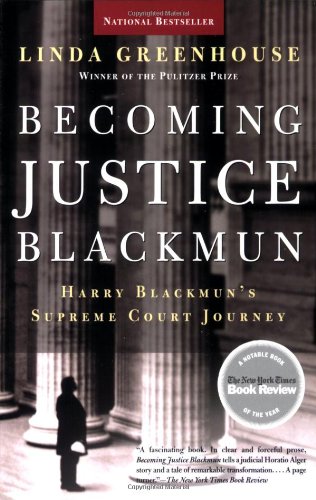This biography of a Supreme Court justice grabs most of its information from Blackmun's own papers and diary. It presents the story of a justice who moves from the right side of the political spectrum to the left during his time on the bench. It also tells the tale of two men whose friendship draws to a close as this transformation takes place.
Blackmun grew up in Minnesota and went to school with another Supreme Court justice, Warren Berger. The two were, thus, long-time friends when they ended up on the Supreme Court together, though their paths to the Court differed. Although Blackmun went to a top law school, he found himself in the middle of the class, after having excelled in college, much to his displeasure. Such is the experience of most law students, I have found out, via my wife.
He then went to work for a nonprofit medical organization, the Mayo Clinic. Berger, meanwhile, went to Washington to clerk and then eventually to serve in the government, before being elevated to the appeals court. Blackmun turned down several opportunities to go work for big law and for D.C. government, but eventually he succumbed, taking a job for the appeals court out in the Midwest.
Berger becomes Chief Justice, and when an opening comes up under the Nixon administration, he suggests Blackmun. The old buddies end up living and working in D.C. together. Both moderate conservatives from Minnesota, there's some expectation that they will vote together on various cases. And that's largely how their time on the Court starts.
Blackmun's big decision was Roe v. Wade, which he wrote for the 7-2 majority. That case, as it turns out, was largely one meant to protect doctors from prosecution and Blackmun's thinking was affected heavily by his time at the Mayo Clinic. However, as time went on, the case became more and more about the Constitution's inferred "right to privacy" and women's rights.
Blackmun's defense of Roe became more and more about these latter things but also, it seemed to me, about protecting his legacy. When new conservative judges such as Sandra Day O'Connor, Anthony Kennedy, and William Rehnquist came on to the Court, Roe seemed likely to fall--and barely survived. The former two, however, over the years, would move to the left as well and eventually uphold Roe in some later cases.
Blackmun went from voting about 90 percent with conservatives to 90 percent with liberals over his years on the Court, moving from the right to the left. Berger did not move as much accordingly, but more than that, as Blackmun became his own man on the Court, not simply taking Berger's same positions, the relationship became strained. One reads as the correspondence between the two grows slimmer and more strained, such that mention of Berger in Blackmun's diary at the time of the former's death is just that and not much more. It's a sad thing to witness.
I was told that Blackmun said that it wasn't he that changed but the Court, that it grew more conservative. But reading the book, I came to feel that in fact it was not just the latter. The Court may have gotten moderately more conservative, but it seems to me that Blackmun moved to the left too (as made evident by the justices with whom he largely voted). Why the shift? Faced with real situations, it was hard to remain an idealist, Blackmun said. Certainly, I can see how one's views could change when faced with real people whose lives may be affected.
Wednesday, October 26, 2016
On "Becoming Justice Blackmun" by Linda Greenhouse ****
Labels:
Books,
Four-Star Nonfiction,
Linda Greenhouse,
Nonfiction
Subscribe to:
Post Comments (Atom)







No comments:
Post a Comment